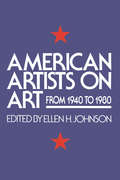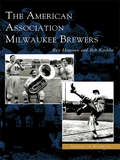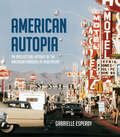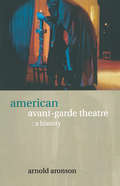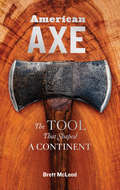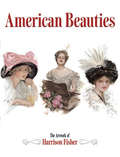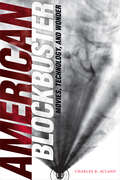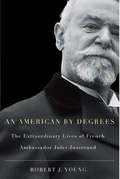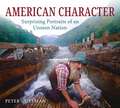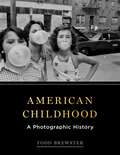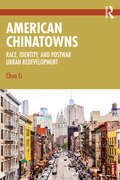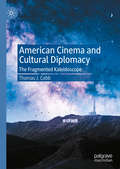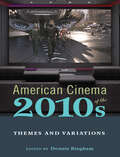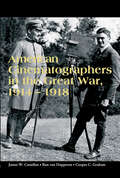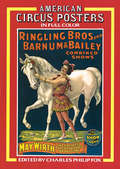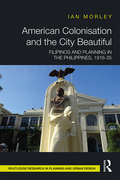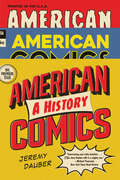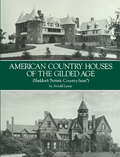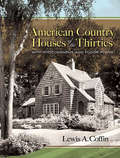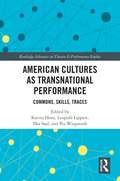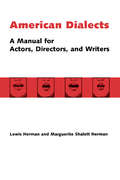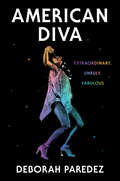- Table View
- List View
American Art, volume 39 number 2 (Summer 2025)
by American ArtThis is volume 39 issue 2 of American Art. American Art publishes innovative peer-reviewed scholarship on the history of art and related visual culture. The journal critically engages with the material and conceptual conditions of art and provides a forum for the expanding field of American art history. It welcomes scholarship on the role played by art in the ongoing transnational and transcultural formation of America as a contested geography, identity, and idea. Committed to rigorous inquiry, the journal presents a range of approaches to the production and consumption of art.
American Artists Engage the Built Environment, 1960-1979 (Routledge Research in Art History)
by Susanneh BieberThis volume reframes the development of US-American avant-garde art of the long 1960s—from minimal and pop art to land art, conceptual art, site-specific practices, and feminist art—in the context of contemporary architectural discourses. Susanneh Bieber analyzes the work of seven major artists, Donald Judd, Robert Grosvenor, Claes Oldenburg, Robert Smithson, Lawrence Weiner, Gordon Matta-Clark, and Mary Miss, who were closely associated with the formal-aesthetic innovations of the period. While these individual artists came to represent diverse movements, Bieber argues that all of them were attracted to the field of architecture—the work of architects, engineers, preservationists, landscape designers, and urban planners—because they believed these practices more directly shaped the social and material spaces of everyday life. This book’s contribution to the field of art history is thus twofold. First, it shows that the avant-garde of the long 1960s did not simply develop according to an internal logic of art but also as part of broader sociocultural discourses about buildings and cities. Second, it exemplifies a methodological synthesis between social art history and poststructural formalism that is foundational to understanding the role of art in the construction of a more just and egalitarian society. The book will be of interest to scholars working in art history, architecture, urbanism, and environmental humanism.
American Artists On Art: From 1940 To 1980
by Sherron SparksFrom the Preface: The fact that so much of modern art has devoted itself to the exploration and assertion of its own identity is reflected in, but does not explain, the increasing amount of writing and talking on the part of contemporary artists. Rather, the whole history of the changing role of art and artists in a democratic, industrial, and technological society stands behind the spate of artists' words and the public's hunger for them--even some of the general public out there beyond art's little circle. Statements by artists appeal somewhat the way drawings do: they bring us, or at least they hold the promise of bringing us, closer to the artist's thoughts and feelings and to an understanding of his or her modus operandi; they hold the keys to a mysterious realm. And sometimes they offer us the sheer pleasure of good reading. Such is the primary raison d'etre of this book.Its other motivation is educational, and stems from the frustrating lack, in teaching contemporary art, of any single compilation of statements by American artists from 1940 to the present.... This anthology differs in several respects from those others that do include documents of American art since 1940.... The selection I have made is devoted exclusively to statements of artists; it is limited to the last four decades; it presents in a single volume a representative and fairly comprehensive coverage of major developments in American art beginning with Abstract Expressionism; and, whenever possible, it cities the first, or among the very earliest, documents signalizing a shift in the definition, intent, or direction of art."
American Association Milwaukee Brewers, The (Images of Baseball)
by Bob Koehler Rex HamannMany people know of Milwaukee's famous beer brewers, such as Schlitz, Pabst, and Miller, but these pages contain the story of the original baseball Brewers. The Milwaukee Brewers of the American Association spent 51 seasons (1902-1952) on the city's near north side. To have had the opportunity to stretch out in the sun-soaked stands of Borchert Field during that era was to witness minor league baseball at its best. The Brewers were the second-winningest franchise in the league's history, and names like Tom "Sugar Boy" Dougherty and Nick "Tomato Face" Cullop were once household words throughout the city. This book stands as a tribute to the colorful history of this team and to all the former players, coaches, and managers who ever wore the woolens for Milwaukee.
American Autopia: An Intellectual History of the American Roadside at Midcentury (Midcentury: Architecture, Landscape, Urbanism, and Design)
by Gabrielle EsperdyEarly to mid-twentieth-century America was the heyday of a car culture that has been called an "automobile utopia." In American Autopia, Gabrielle Esperdy examines how the automobile influenced architectural and urban discourse in the United States from the earliest days of the auto industry to the aftermath of the 1970s oil crisis. Paying particular attention to developments after World War II, Esperdy creates a narrative that extends from U.S. Routes 1 and 66 to the Las Vegas Strip to California freeways, with stops at gas stations, diners, main drags, shopping centers, and parking lots along the way.While it addresses the development of auto-oriented landscapes and infrastructures, American Autopia is not a conventional history, offering instead an exploration of the wide-ranging evolution of car-centric territories and drive-in typologies, looking at how they were scrutinized by diverse cultural observers in the middle of the twentieth century.Drawing on work published in the popular and professional press, and generously illustrated with evocative images, the book shows how figures as diverse as designer Victor Gruen, geographer Jean Gottmann, theorist Denise Scott Brown, critic J.B. Jackson, and historian Reyner Banham constructed "autopia" as a place and an idea. The result is an intellectual history and interpretive roadmap to the United States of the Automobile.
American Avant-Garde Theatre: A History (Theatre Production Studies)
by Arnold AronsonThis stunning contribution to the field of theatre history is the first in-depth look at avant-garde theatre in the United States from the early 1950s to the 1990s. American Avant-Garde Theatre offers a definition of the avant-garde, and looks at its origins and theoretical foundations by examining: *Gertrude Stein *John Cage *The Beat writers *Avant-garde cinema *Abstract Expressionism *Minimalism There are fascinating discussions and illustrations of the productions of the Living Theatre, the Wooster Group, Open Theatre, Ontological-Hysteric Theatre and Performance Group. among many others. Aronson also examines why avant-garde theatre declined and virtually disappeared at the end of the twentieth century.
American Axe: The Tool That Shaped a Continent
by Brett McLeodFrom bronze axes of the Viking conquests to the American homesteader&’s felling axe, this is a tool that has shaped human history like few others. American Axe pays tribute to this iconic instrument of settlement and industry, with rich history, stunning photography, and profiles of the most collectible vintage axes such as The Woodslasher, Keen Cutter, and True Temper Perfect. Combining his experiences as a forester, axe collector, and former competitive lumberjack, author Brett McLeod conveys the allure of this deceptively simple woodcutting implement and celebrates the resurging interest in its story and use.
American Beauties: The Artwork of Harrison Fisher
by Harrison FisherHarrison Fisher's portraits of healthy, poised, active, and confident women set the standard of American beauty in the early 20th century -- and he enjoyed a celebrity status that was unparalled for an illustrator. This original publication compiles his very best black-and-white and color illustrations for Cosmopolitan, The Saturday Evening Post, books, and other publications.
American Blockbuster: Movies, Technology, and Wonder (Sign, Storage, Transmission)
by Charles R. AclandBen-Hur (1959), Jaws (1975), Avatar (2009), Wonder Woman (2017): the blockbuster movie has held a dominant position in American popular culture for decades. In American Blockbuster Charles R. Acland charts the origins, impact, and dynamics of this most visible, entertaining, and disparaged cultural form. Acland narrates how blockbusters emerged from Hollywood's turn to a hit-driven focus during the industry's business crisis in the 1950s. Movies became bigger, louder, and more spectacular. They also became prototypes for ideas and commodities associated with the future of technology and culture, accelerating the prominence of technological innovation in modern American life. Acland shows that blockbusters continue to be more than just movies; they are industrial strategies and complex cultural machines designed to normalize the ideologies of our technological age.
American By Degrees: The Extraordinary Lives of French Ambassador Jules Jusserand
by Robert J. YoungThe expressions of American hostility toward France after 9/11 are not new - Franco-American relations in the early twentieth century were also difficult, characterized by the same antagonistic depictions of the other's culture. Ambassador Jules Jusserand's years in Washington (1903-24) were defined by efforts to correct such misconceptions, whether they came from the venomous pens of French extremists or from members of William Randolph Hearst's press empire. In An American by Degrees Robert Young explores Ambassador Jusserand's life and legacy. Fluent in English, married to an American, and a historian who was a frequent guest at many American universities, Jusserand deftly cultivated American sympathies for France. His tasks as a diplomat were formidable, whether during the period of America's war-time neutrality - when France was nearly over-run by the German army - or when as allies they competed for control of the peace process or sought to resolve post-war issues like disarmament, war debts, and reparations. Jusserand relentlessly reminded Americans that France had been an ally during their Revolution and that their concept of "civilization" was part of France's intellectual and cultural legacy. His emphasis on their shared history was natural, as befitted the first winner of the Pulitzer Prize in History and only the second foreigner to serve as president of the American Historical Association.
American Character: Surprising Portraits of an Unseen Nation
by Peter GuttmanAward-winning photographer Peter Guttman showcases the vibrant and wildly diverse American people in an unprecedented, multi-decade collection of sharply etched portraits Like few nations, the United States flourished through the hard work and enterprising creativity of individuals from myriad identities. These cultural strands––along with sprinklings of imagination, eccentricity, even skullduggery––weave together an entertaining narrative of a fascinating country. American Character offers readers a peek into the seldom viewed worlds of Buddhist monks, "freak show" performers, and nuclear physicists, and an opportunity to tag along on the quests of gold miners and Bigfoot hunters. Diving into the ethnic enclaves of Yupik hunters, Amish farmers, Hopi elders, native Hawaiian storytellers, and Hasidic bakery owners, the book also trains a lens on distant or underseen communities to cobble together an unforgettable American landscape. Driven by an explorer&’s fearless instinct for investigating obscure cultures and hidden corners in all fifty states, photographer and journalist Peter Guttman presents this richly visual parade in stunning color photography, accompanied with evocative, deeply researched prose. Almost encyclopedic in scope, a dizzying array of arresting occupational niches and lifestyles are presented and enhanced with intriguing personal backstories, winding connections, and amusing historical tales. When each half of a polarized country seems to view the other half with deep suspicions, American Character may provide a healing balm and offer much deeper understanding of the vast spectrum of Americans and our mutual aspirations.
American Childhood: A Photographic History
by Todd BrewsterA remarkable collection of over 200 stunning photographs of children—from the Civil War era to the present—that captures the ever-changing experience of childhood throughout American history.Did Americans &“invent&” childhood? Author Todd Brewster believes we did, or at least childhood as &“a period of life cordoned off from that of full maturity, covered with a veil of protection, and subject to a program of nurture.&” That&’s the inspiration behind this rich, compelling volume of rarely seen historical images drawn from the photography collections at the Library of Congress, The Metropolitan Museum of Art, the New York Public Library, and the Magnum Photo Agency as well as dozens of other archives, flea markets, and antique shops. The result is a carefully curated paean to American youth: 200-plus photos from all parts of American history, joined by a series of deeply insightful essays on the topic of the American child. American Childhood reveals American children of all types: white, Black, gay, straight, poor, middle-class, upper class, in cities, on farms, at work, at play, lost in reverie, posing for the camera, or captured in their innocence as the lens gazes at them from afar. Some of them would go on to fame: A young Mark Twain is here. So is a juvenile Thomas Edison, Shirley Temple, Lady Gaga, Sammy Davis Jr., Truman Capote, and dozens of others. Can you see the spark of genius in the life of a child? Brewster thinks so. Still, most subjects here are unknown; in many cases a photograph may be the only public trace they have left behind. Both a powerful study of American childhood and a beautiful gallery of extraordinary photography, American Childhood is a terrific addition to an under-appreciated part of American history.
American Chinatowns: Race, Identity, and Postwar Urban Redevelopment
by Chuo LiAmerican Chinatowns: Race, Identity, and Postwar Urban Redevelopment offers a captivating exploration of the vibrant yet contested landscapes of Chinatowns across the United States.Through a critical and nuanced lens, Li examines how postwar urban redevelopment, racial dynamics, and identity politics have profoundly transformed these iconic neighborhoods. Blending rich historical research with sharp analysis, this book uncovers the interplay of race, urban planning ideologies, and social equity, shedding light on how Chinatowns navigate resilience and reinvention amid shifting urban paradigms. Li’s work highlights the tension between cultural preservation and modernization, exploring the built environment alongside community-driven spatial activism to reveal how these urban spaces persist as sites of resistance, identity, and transformation. American Chinatowns is a compelling study of cultural landscape, urban justice, and the politics of city-making.This book is essential reading for scholars, urbanists, and anyone intrigued by the intersection of race, identity, and the evolving narratives of America’s cities. This book invites readers to rethink the meaning of place, heritage, and equity in the urban fabric.
American Cinema and Cultural Diplomacy: The Fragmented Kaleidoscope
by Thomas J. CobbThis book contends that Hollywood films help illuminate the incongruities of various periods in American diplomacy. From the war film Bataan to the Revisionist Western The Wild Bunch, cinema has long reflected US foreign policy’s divisiveness both directly and allegorically. Beginning with the 1990s presidential drama The American President and concluding with Joker’s allegorical treatment of the Trump era, this book posits that the paradigms for political reflection are shifting in American film, from explicit subtexts surrounding US statecraft to covert representations of diplomatic disarray. It further argues that the International Relations theorist Walter Mead’s concept of a US polity dominated by contesting beliefs, or a ‘kaleidoscope’, permeates these changing paradigms. This synergy reveals a cultural milieu where foreign policy fissures are increasingly encoded by cinematic representation. The interdisciplinarity of this focus renders this book pertinent reading for scholars and students of American Studies, Film Studies and International Relations, along with those generally interested in Hollywood filmmakers and foreign policy.
American Cinema of the 2010s: Themes and Variations (Screen Decades: American Culture/American Cinema)
by Cynthia Baron David Greven Julie Levinson Daniel Smith-Rowsey Lisa Bode Alexandra Keller Michele Schreiber Raymond Haberski Jr. Dennis Bingham Mikal J. GainesThe 2010s might be remembered as a time of increased polarization in American life. The decade contained both the Obama era and the Trump era, and as the nation’s political fissures widened, so did the gap between the haves and have-nots. Hollywood reflected these divisions, choosing to concentrate on big franchise blockbusters at the expense of mid-budget films, while new players like Netflix and Amazon offered fresh opportunities for low-budget and independent filmmakers. As the movie business changed, films ranging from American Sniper to Get Out found ways to speak to the concerns of a divided nation. The newest installment in the Screen Decades series, American Cinema in the 2010s takes a close look at the memorable movies, visionary filmmakers, and behind-the-scenes drama that made this decade such an exciting time to be a moviegoer. Each chapter offers an in-depth examination of a specific year, covering a wide variety of films, from blockbuster superhero movies like Black Panther and animated films like Frozen to smaller-budget biopics like I, Tonya and horror films like Hereditary. This volume introduces readers to a decade in which established auteurs like Quentin Tarantino were joined by an exceptionally diverse set of new talents, taking American cinema in new directions.
American Cinematographers in the Great War, 1914–1918
by James W. Castellan Ron van Dopperen Copper C. GrahamA history of American cameramen covering the news of World War I, from the dangerous front line and the risk of execution to red tape and censorship.At the start of hostilities in World War I, when the United States was still neutral, American newsreel companies and newspapers sent a new kind of journalist, the film correspondent, to Europe to record the Great War. These pioneering cameramen, accustomed to carrying the Kodaks and Graflexes of still photography, had to lug cumbersome equipment into the trenches. Facing dangerous conditions on the front, they also risked summary execution as supposed spies while navigating military red tape, censorship, and the business interests of the film and newspaper companies they represented. Based on extensive research in European and American archives, American Cinematographers in the Great War, 1914–1918 follows the adventures of these cameramen as they managed to document and film the atrocities around them in spite of enormous difficulties.“The first book to explore the work and working conditions of American cinematographers active on the different fronts of the First World War. It is a pioneering study which has already attracted a good deal of attention in the academic and archive world.” —Historical Journal of Film, Radio and Television
American Circus Posters
by Charles Philip FoxThe Children's Dream of Fairy-Land (1893) . . . Living Statues on Horseback (1890s) . . . Real Roman Hippodrome, Five Continent Menagerie (1890s) . . . Uno, Queen Supreme of the Serpent Kingdom (1894) . . . Dancing Girls, Mounted Guards and Truly Lavish Displays (1903) . . . "Twisting Double Somersault," A Feat Never Before Attempted by the Most Intrepid Aerialists (1904) . . . Desperado's Terrible Leap for Life, A Terrific Descent of 80 Feet Through Space Landing Upon His Chest on a Skid (1909) . . . The Imperial Chinese Circus Stars (1914) . . . An Army of Clowns (1920s) . . . Pallenberg's Wonder Bears (1920s) . . . Gargantua the Great (1938).Originally put in store windows and posted on sheds, barns, buildings, walls and fences, these 18 extremely rare posters, most not previously reproduced, are collected together for the first time. The quality of reproduction is superb: reproduced in full color directly from the originals, these posters have been printed in an extra large format and on coated stock so that every detail is clear. They are an exciting visual history, capturing the pageantry and color that the circus was and is. They are also extremely fine examples of almost 50 years of poster art and American advertising. There are acrobats, elephants, tigers, lions, parades, tents, trains, and many specialized acts: May Wirth, the Riding Rooneys, the Astounding Clarkonians, etc. The posters date from the 1890s to the 1940s, and include one by Norman Bel Geddes. They feature many American circuses: Ringling Bros., Barnum & Bailey, Sells, Sparks, Hagenbeck-Wallace. The historical introduction and captions are by Charles Philip Fox, Director of Research and Development with the Ringling Bros. and Barnum & Bailey Circus.
American Colonisation and the City Beautiful: Filipinos and Planning in the Philippines, 1916-35
by Ian MorleyAmerican Colonisation and the City Beautiful explores the history of city planning and the evolution of the built environment in the Philippines between 1916 and 1935. In so doing, it highlights the activities of the Bureau of Public Works’ Division of Architecture as part of Philippine national development and decolonisation. Morley provides new archival materials which deliver significant insight into the dynamics associated with both governance and city planning during the American colonial era in the Philippines, with links between prominent American university educators and Filipino architecture students. The book discusses the two cities of Tayabas and Iloilo which highlight the significant role in the urban design of places beyond the typical historiographical focus of Manila and Baguio. These examples will aid in further understanding the appearance and meaning of Philippine cities during an important era in the nation’s history. Including numerous black and white images, this book is essential for academics, researchers and students of city and urban planning, the history and development of Southeast Asia and those interested in colonial relations.
American Comics: A History
by Jeremy DauberThe sweeping story of cartoons, comic strips, and graphic novels and their hold on the American imagination. Comics have conquered America. From our multiplexes, where Marvel and DC movies reign supreme, to our television screens, where comics-based shows like The Walking Dead have become among the most popular in cable history, to convention halls, best-seller lists, Pulitzer Prize–winning titles, and MacArthur Fellowship recipients, comics shape American culture, in ways high and low, superficial, and deeply profound. In American Comics, Columbia professor Jeremy Dauber takes readers through their incredible but little-known history, starting with the Civil War and cartoonist Thomas Nast, creator of the lasting and iconic images of Uncle Sam and Santa Claus; the golden age of newspaper comic strips and the first great superhero boom; the moral panic of the Eisenhower era, the Marvel Comics revolution, and the underground comix movement of the 1960s and ’70s; and finally into the twenty-first century, taking in the grim and gritty Dark Knights and Watchmen alongside the brilliant rise of the graphic novel by acclaimed practitioners like Art Spiegelman and Alison Bechdel. Dauber’s story shows not only how comics have changed over the decades but how American politics and culture have changed them. Throughout, he describes the origins of beloved comics, champions neglected masterpieces, and argues that we can understand how America sees itself through whose stories comics tell. Striking and revelatory, American Comics is a rich chronicle of the last 150 years of American history through the lens of its comic strips, political cartoons, superheroes, graphic novels, and more. FEATURING… • American Splendor • Archie • The Avengers • Kyle Baker • Batman • C. C. Beck • Black Panther • Captain America • Roz Chast • Walt Disney • Will Eisner • Neil Gaiman • Bill Gaines • Bill Griffith • Harley Quinn • Jack Kirby • Denis Kitchen • Krazy Kat • Harvey Kurtzman • Stan Lee • Little Orphan Annie • Maus • Frank Miller • Alan Moore • Mutt and Jeff • Gary Panter • Peanuts • Dav Pilkey • Gail Simone • Spider-Man • Superman • Dick Tracy • Wonder Wart-Hog • Wonder Woman • The Yellow Kid • Zap Comix … AND MANY MORE OF YOUR FAVORITES!
American Country Houses of the Gilded Age: (Sheldon's "Artistic Country-Seats") (Dover Architecture)
by A. LewisThe "Gilded Age," the three decades following the Civil War, were years of astounding economic growth. Vast empires in oil, shipping, mining, banking, lumber, transportation, and related industries were formed. It was an era in which fortunes were made and lost quickly, almost easily; a period that encouraged - nearly demanded - the public display of this newly acquired wealth, power, and prestige. It was during these heady, turbulent years that a new type of domestic architecture first appeared on the American landscape. Called the "country seat" or "cottage," these houses were grandiose in scale - imposing facades complemented by manicured gardens, with exceptionally large and impressive reception rooms, halls, parlors, dining rooms, and other public areas. Intended exclusively for the very well-to-do, these buildings were designed by some of the finest and most influential architectural firms in America: McKim, Mead & White; Bruce Price; Peabody & Stearns; Theophilus P. Chandler, Jr.; Lamb & Rich; Wilcox & Johnston; and many others. The first, best, and most exquisite documentation of this surge of architectural creativity was the 1886-87 publication of George William Sheldon's Artistic Country-Seats: Types of Recent American Villa and Cottage Architecture with Instances of Country-Club Houses. It presented exceedingly fine photographs, clearly detailed plans and elevations, as well as Sheldon's own commentary for a total of 97 buildings (93 houses and 4 casinos). Most structures were located in new England and the Middle Atlantic states, and embraced the full spectrum of architectural and artistic expressions. This present volume reproduces all of Sheldon's fascinating and historically important photographs and plans, and adds a new, thoroughly accurate text by Arnold Lewis (Professor of Art, the College of Wooster, Wooster, Ohio) that includes the most useful information supplied by Sheldon and also reports on the present condition of each house or casino, providing analyses of elevations and plans, observations about family life in the 1880s, and brief biographical comments about the clients and architects. Sheldon's photographs connect us with a time and style of living that today increasingly seem more the realm of fiction than fact. Yet, in the pages of this important collection, they are brought fresh to life as they appeared when they were new and times were very different.
American Country Houses of the Thirties: With Photographs and Floor Plans
by Lewis A. CoffinAbout 1912, a renaissance of interest in early American architecture occurred that claimed the attention of a broad cross-section of the culture. It was demonstrated not only by being a popular topic in books and magazines, but also by the public's passion for collecting American antique furniture, and by students and architects traveling through different regions of the nation and photographing the most notable architectural examples. In the 1930s, the classic constructions from this earlier time mingled with the new materials and efficient designs, and the great American country house was born. This treasury showcases some of the finest American country houses produced during that unusually fruitful period. Culled from many of the best architectural firms of the time, the volume includes numerous detailed floor plans, lively sketches, and breathtaking photographs of exteriors and interiors. From simple cottages to functional family homes to sprawling estates, a wide variety of styles is represented. Celebrating the stately form, quiet technique, and balance and simplicity that is at the heart of every well-built American country house, anyone interested in history, art, and architecture will find in this collection an inspiring vision.
American Cultures as Transnational Performance: Commons, Skills, Traces (Routledge Advances in Theatre & Performance Studies)
by Katrin Horn Ilka Saal Pia Wiegmink Leopold LippertThis book investigates transnational processes through the analytic lens of cultural performance. Structured around key concepts of performance studies––commons, skills, and traces––this edited collection addresses the political, normative, and historical implications of cultural performances beyond the limits of the (US) nation-state. These three central aspects of performance function as entryways to inquiries into transnational processes and allow the authors to shift the discussion away from text-centered approaches to intercultural encounters and to bring into focus the dynamic field that opens up between producer, art work, context, setting, and audience in the moment of performance as well as in its afterlife. The chapters provide fresh, performance-based approaches to notions of transcultural mobility and circulation, transnational cultural experience and knowledge formation, transnational public spheres, and identities’ rootedness in both specific local places and diasporic worlds beyond the written word. This book will be of great interest to scholars and students of American studies, performance studies, and transnational studies
American Denim: The Supposed Final Days and Resurgence of a Manufacturing Icon
by Matt SharkeyAmerican Denim aims to preserve a unique property and a unique time in the history of American textiles. At one time the world&’s largest denim mill, occupying more than a million square feet, you almost couldn&’t see where the looms ended at the White Oak mill in Greensboro, North Carolina. Between 1915 and 1970, the lion&’s share of denim produced for Levi Strauss & Co. was made there. Photographer Matt Sharkey was the only person granted access to all three recent stages of the White Oak mill&’s life: • the last week of commercial production in December 2017 • empty and vacated in February 2018 • brought back to life in a small but mighty way in September 2022 Here is a layered history told through beautifully honest "portraits" that were captured with film, an analog process to honor analog manufacturing and those who worked, and work, at the mill.
American Dialects: A Manual for Actors, Directors, and Writers
by Lewis Herman Marguerite Shalett HermanThis standard text, now in paperback for the first time-- the companion volume to Foreign Dialects-- American Dialects offers representative dialects of every major section of the United States. In each case, a general description and history of the dialect is given, followed by an analysis of vowel and consonant peculiarities, of its individual lilt and rhythm, and of its grammar variations. There are also lists of the idioms and idiomatic expressions that distinguish each dialect and exercises using them. American Dialects also includes musical inflection charts and diagrams showing the placement of lips, tongue, and breath.
American Diva: Extraordinary, Unruly, Fabulous
by Deborah ParedezAn impassioned homage to the divas who shake up our world and transform it with their bold, dazzling artistry. What does it mean to be a “diva”? A shifting, increasingly loaded term, it has been used to both deride and celebrate charismatic and unapologetically fierce performers like Aretha Franklin, Divine, and the women of Labelle. In this brilliant, powerful blend of incisive criticism and electric memoir, Deborah Paredez—scholar, cultural critic, and lifelong diva devotee—unravels our enduring fascination with these icons and explores how divas have challenged American ideas about feminism, performance, and freedom. American Diva journeys into Tina Turner’s scintillating performances, Celia Cruz’s command of the male-dominated salsa world, the transcendent revival of Jomama Jones after a period of exile, and the unparalleled excellence of Venus and Serena Williams. Recounting how she and her mother endlessly watched Rita Moreno’s powerhouse portrayal of Anita in West Side Story and how she learned much about being bigger than life from her fabulous Tía Lucia, Paredez chronicles the celebrated and skilled performers who not only shaped her life but boldly expressed the aspiration for freedom among brown, Black, and gay communities. Paredez also traces the evolution of the diva through the decades, dismayed at the mid-aughts’ commodification and juvenilizing of its meaning but finding its lasting beauty and power. Filled with sharp insights and great heart, American Diva is a spirited tribute to the power of performance and the joys of fandom.


